Cross posted from the original Pinside thread, this is one of many posts regarding my third homebrew pinball machine, creatively nicknamed 'P3'
Finally got the lights all working, and coded a simple attract mode animation for them. Originally I was trying to use an existing server I found for controlling ws2812 leds, but it kept crashing and wasn't very suited for pinball animations, so I coded a simple server myself which just handles a light being on, flashing, or pulsing, with settings for frequency and phase. I think I will need to tweak my colors a bit though. Not sure if it's because of the specific leds I got, or the way the opaque white inserts are coloring it, but everything feels a bit 'pastel'...
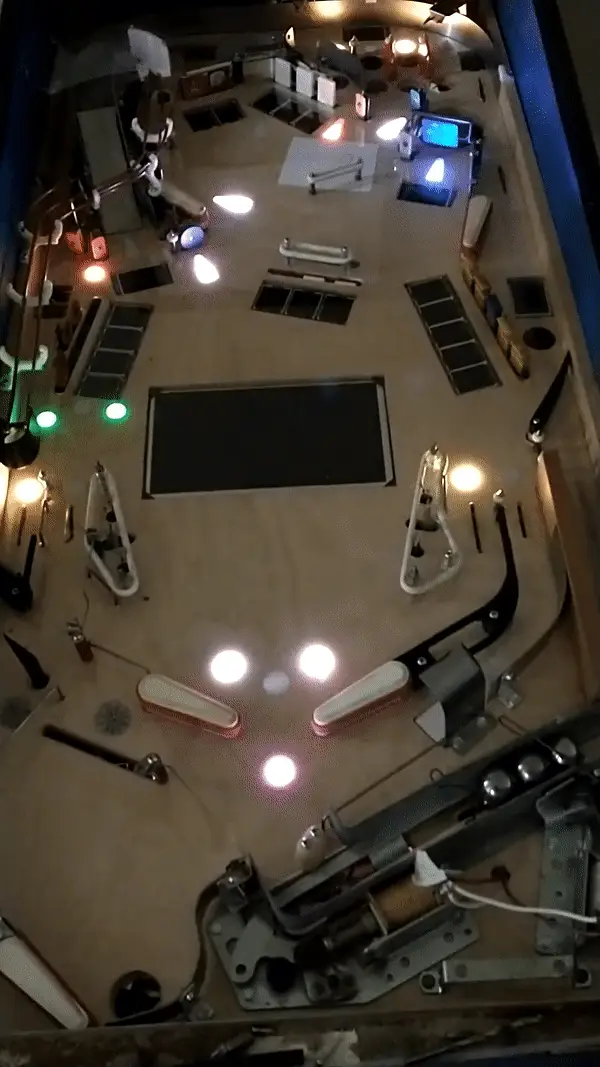
The downside to doing all your leds as one giant strip, I guess, is that if you want to change them later it's more complicated. And of course, once I got everything together here, I realized I'd forgotten to install a light for the lower playfield diverter. So I guess at some point I'll need to cut a bit from my left over led strip, attach that there, then cut my existing strip somewhere, and run the data line over to the new led and back again.
I'm also thinking about maybe having a sort of 'wizard mode' accessible after you get all the main hands (at least straight, flush, full house, since technically those cover all the 'lower' hands too. maybe four of a kind, but it's hard to guarantee there's ever a deal with 4 of the same card), so it'd be nice to have a few more inserts in the barren center area between the screen+slings for that. Just when I thought I had all the lights/etc figured out!
Cross posted from the original Pinside thread, this is one of many posts regarding my third homebrew pinball machine, creatively nicknamed 'P3'
I'd been getting tired of using the projector for everything, and with the lights taking away half of its use, I figured it was a good time to get to work on the other part of that: the cards themselves. I'd realized early on that having all the cards just printed on the playfield, unchangeable, would have a possibility for people finding certain cards to go for every time which would make the game less fun, and having the projector able to deal a random set of cards onto the playfield solidified that worry. And then I found some cheap LCD displays on ali express while searching for the main screen I installed before 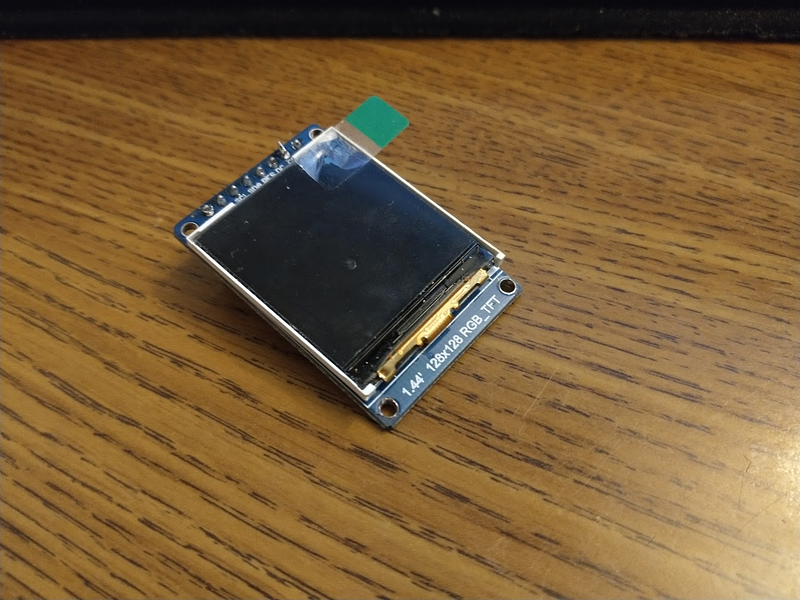
Turns out they were slightly narrower than the spacing on the drop targets: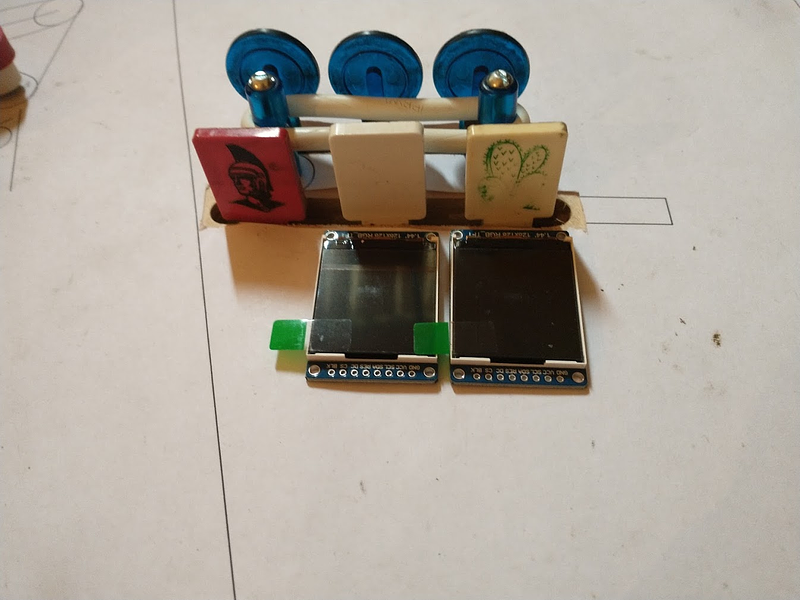
Thanks to the provided example code it wasn't very hard to get one to display a card using a raspberry pi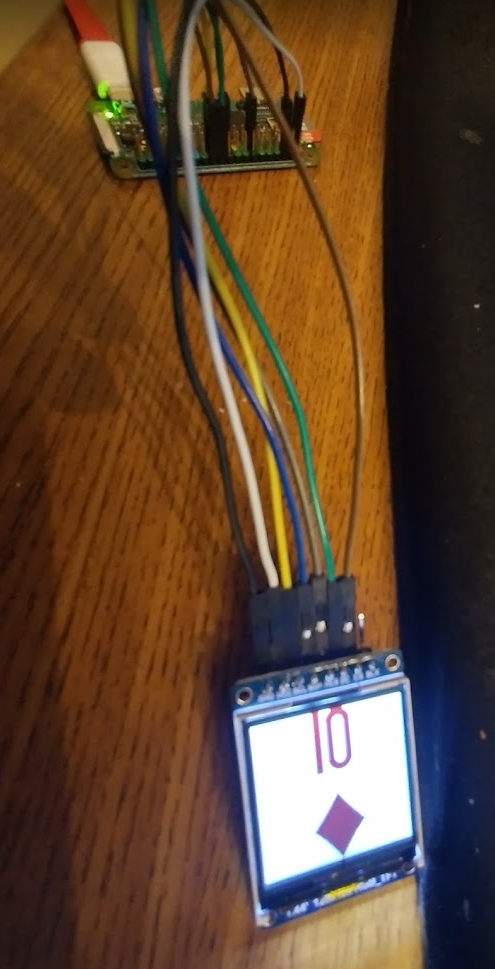
But could you drive more than one easily? I made a little board that had a shift register on it to control the CS line of the display, so that I could theoretically wire up to 8 displays to it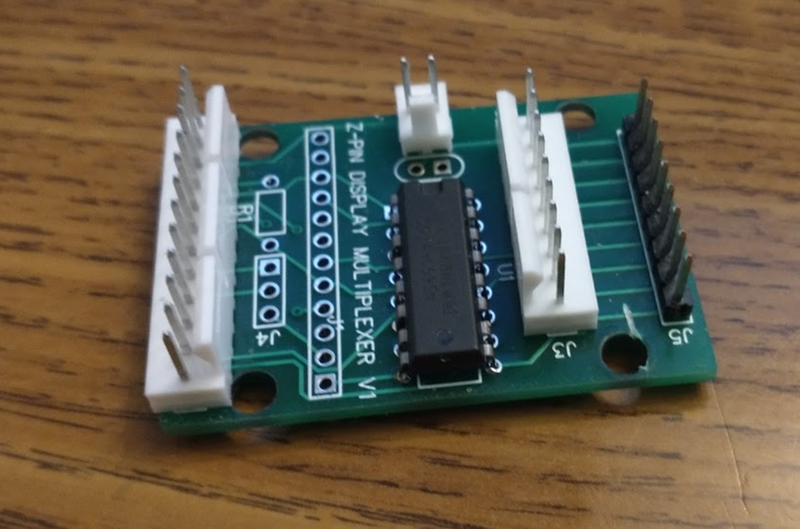
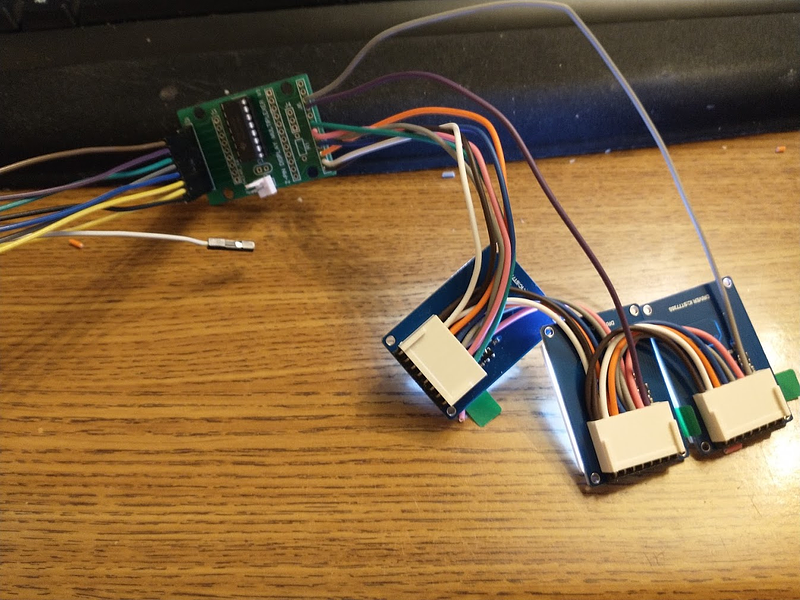
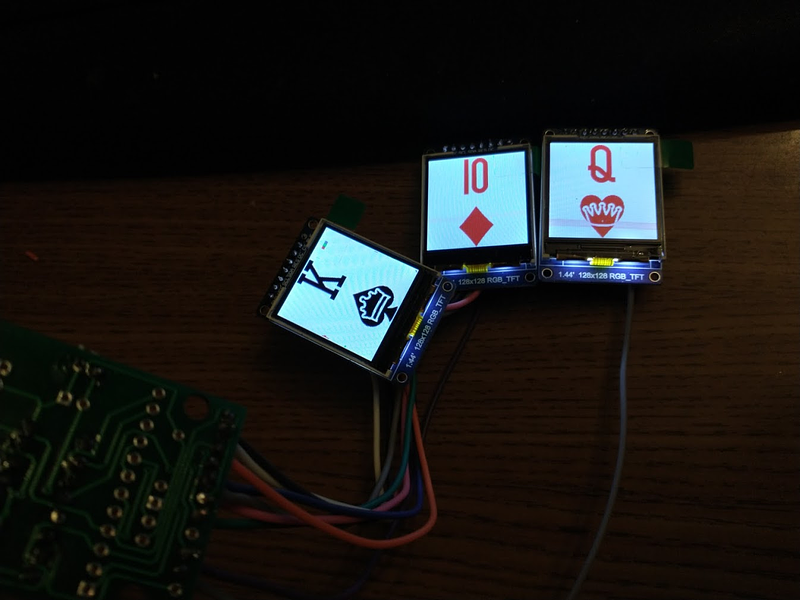
So far so good! Now, could I fit those displays in front of the targets? I did some measurements of the 3 bank in the middle and printed a bracket
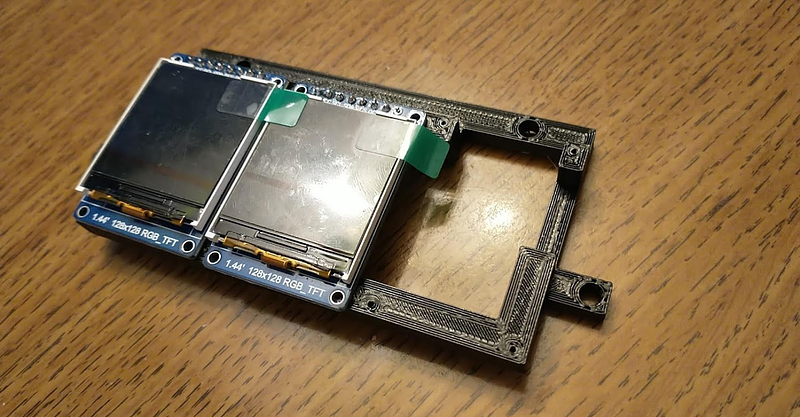
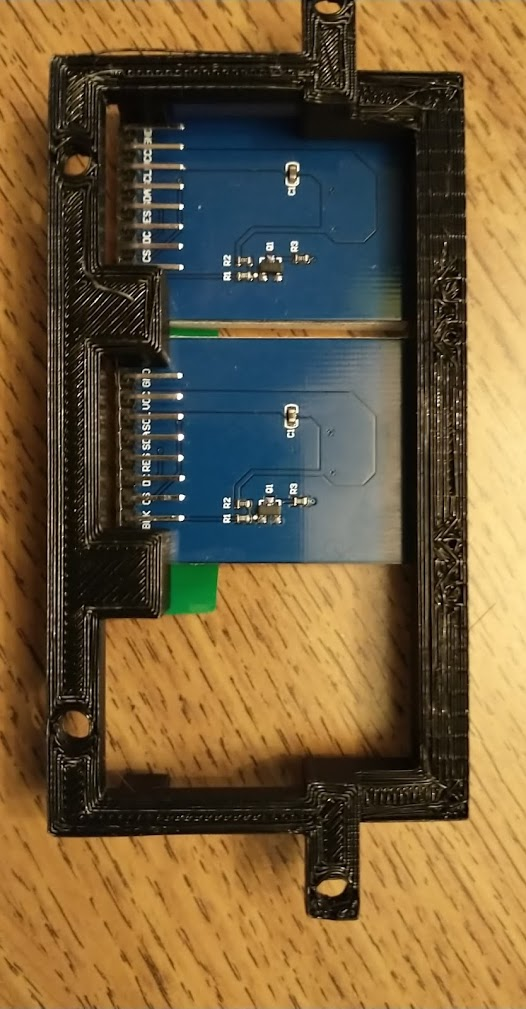
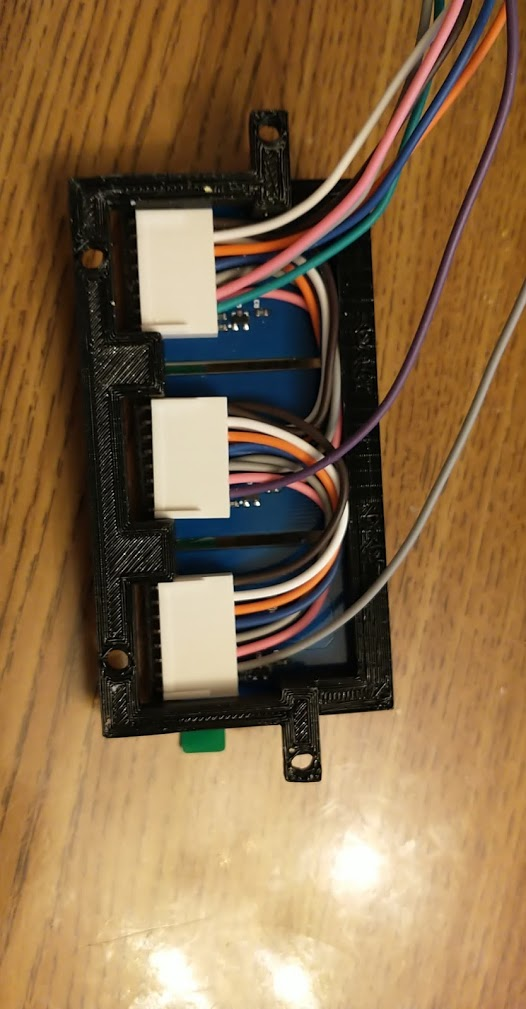
And they fit! barely.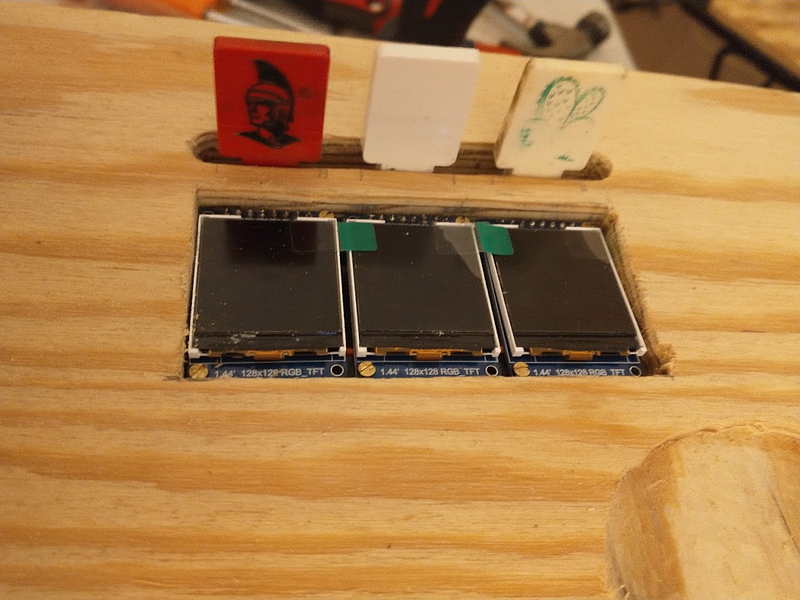
I programmed a simple tcp server to control them, and hooked the 3 displays into the game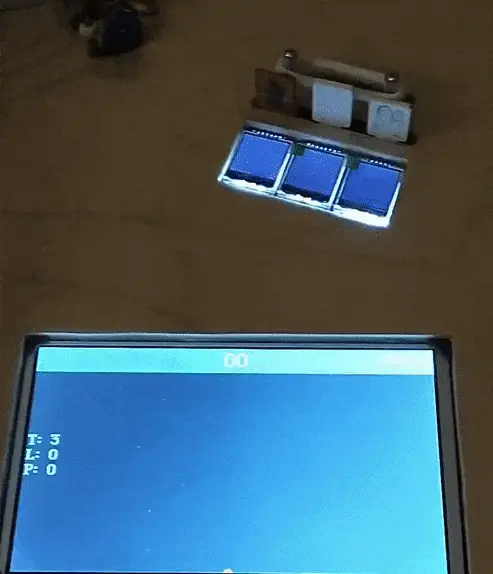
Alright, proof of concept complete. Time to go way too far with this.
I'll need to custom make a bracket for every bank in the game, since they're all different manufacturers+sizes
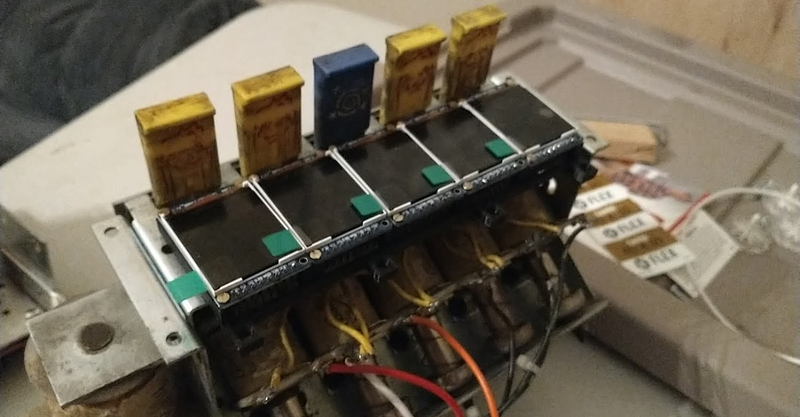
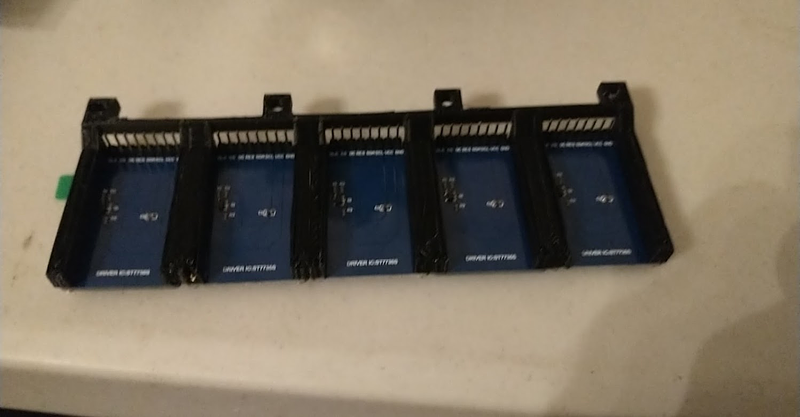
And since I'm already getting into this, why not throw some other single displays around the playfield?
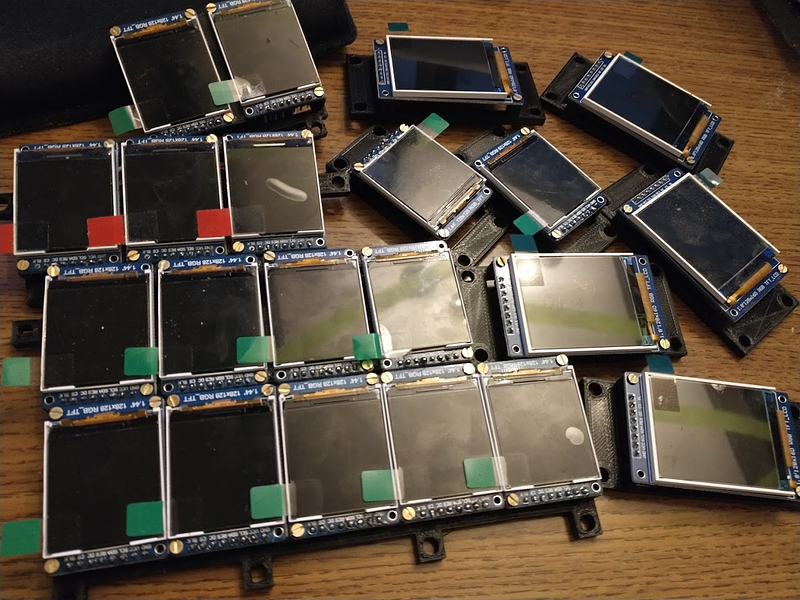

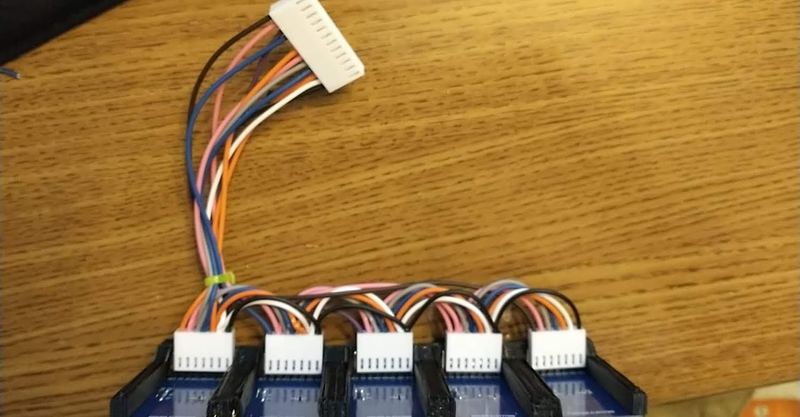
Now, can I actually drive them all? No. I lose signal around the fourth board. A lot of learning about signal integrity and I've got another version of my board with some termination resistors and a buffer chip to redrive the signal between each board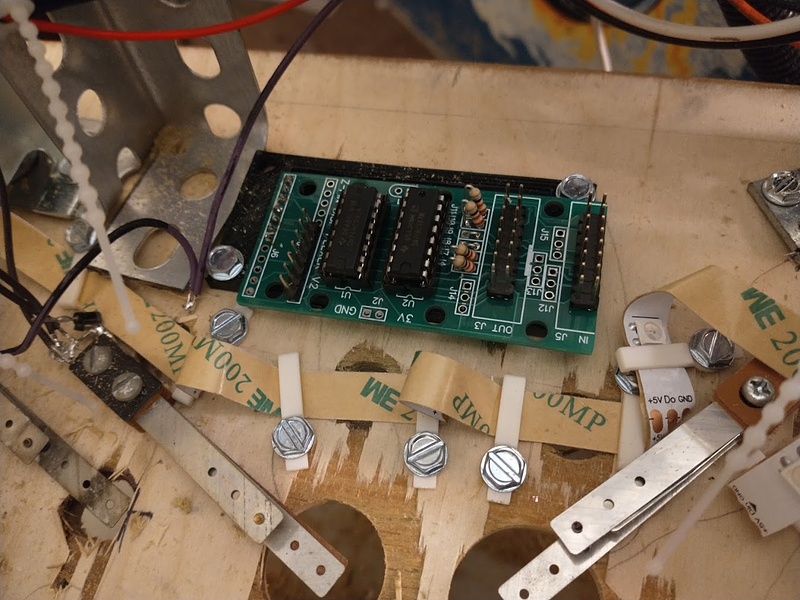
And with that, I can barely get all my displays to work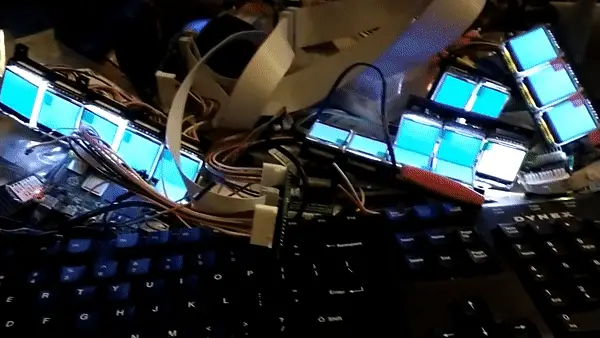
So I cross my fingers and cut a lot of big holes in my playfield. The amount of missing wood at this point is starting to concern me a bit, but it seems to hold up okay when the side rails are attached. 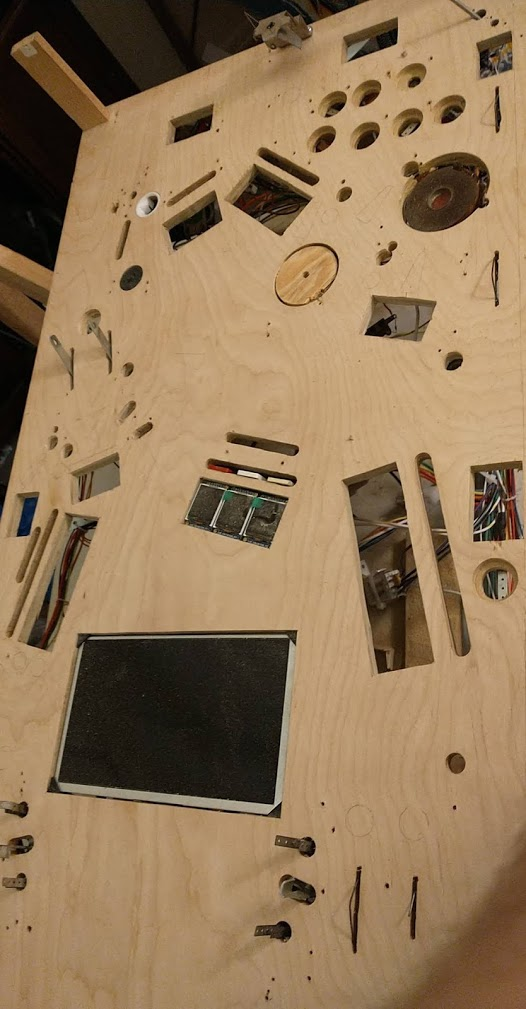
Wiring them up is also fun. So many ribbon cables! Almost looks like a Spooky game...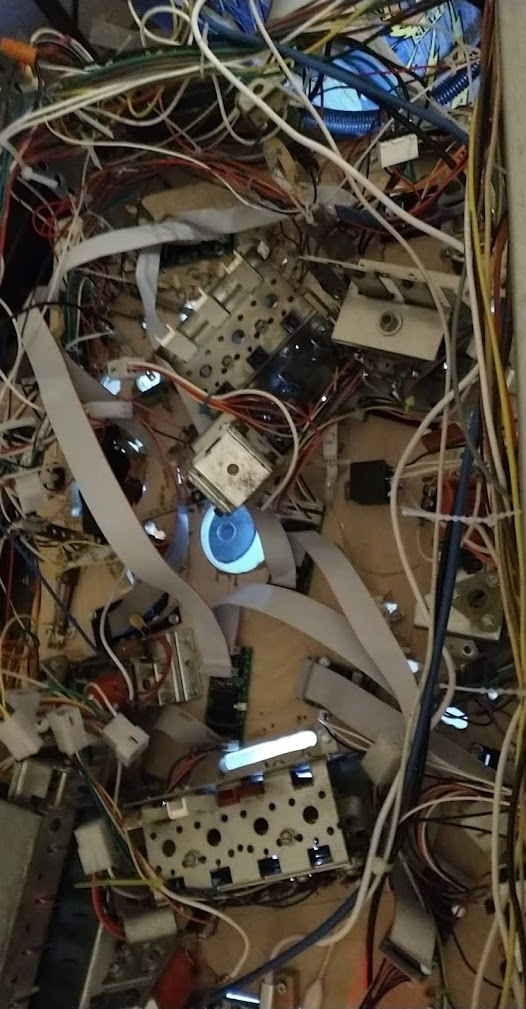
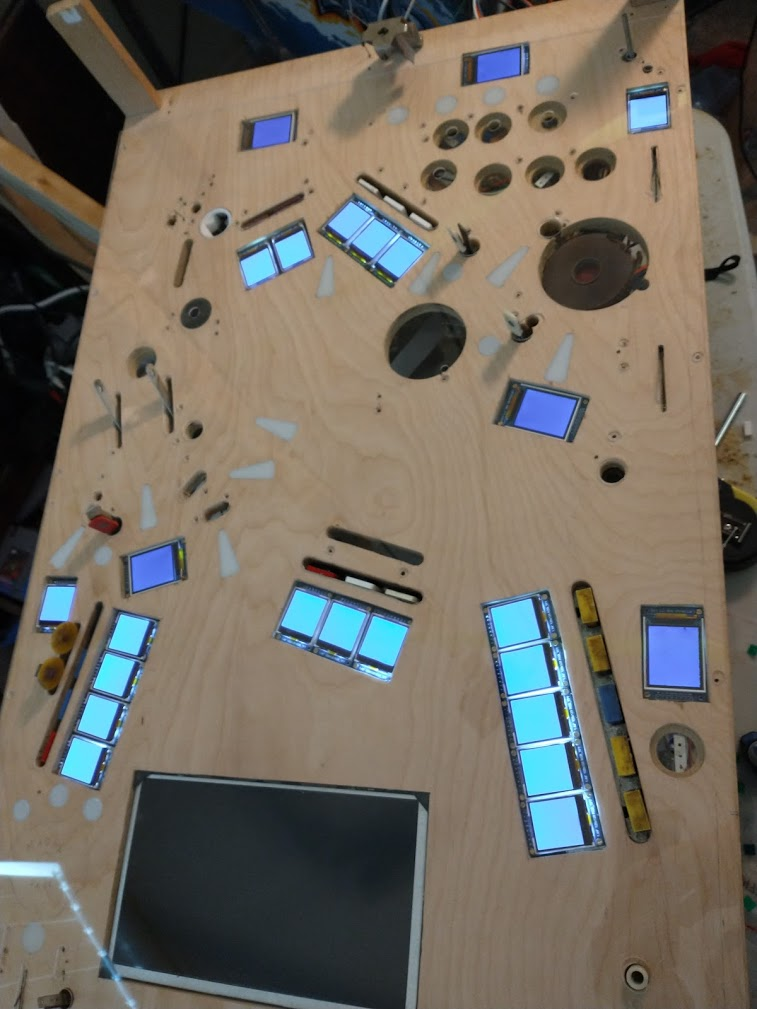
And once I finally got the whole playfield reassembed...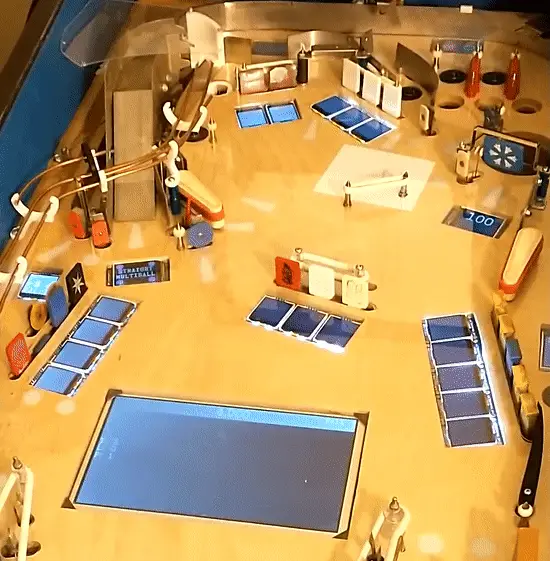
Success!
Cross posted from the original Pinside thread, this is one of many posts regarding my third homebrew pinball machine, creatively nicknamed 'P3'
Still working on a bunch of stuff so I don't actually have any top side pictures yet but..... light!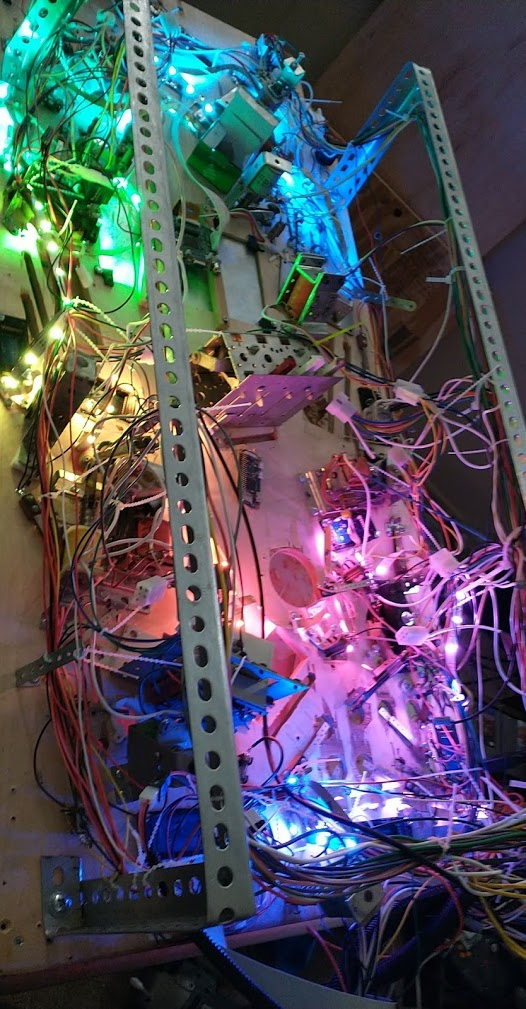
The funny side effect of just trailing a light strip around the playfield is actually looks cool underneath too.
I ended up using 126 LEDs worth of 30/m strip to reach all ~30 inserts on the playfield. Besides from a few places where I didn't plan for lights and had too many mechs in the way, it was pretty easy to mount the strip over the the holes. The budget pack of clips I found are a bit too big, so there's still a bit of back and forth play, but I don't think there'll be enough movement to cause any issues. 
I hooked the strip up to a dedicated 5v line+fuse coming from my ATX PSU, and it seems to be lighting fine with just that power coming in at one end (I was sorta expecting needing to provide more power somewhere along the length), even with all the lights on (which will never happen in practice). I had to make another little adapter board for my RPi-powered MPU to add in a 3V - 5V level shifter since the RPi only puts out 3V, but that seems to be fine for driving the whole strip, with an added 4ft of wire between the board and the beginning of the strip. Time will tell whether the electrical noise interferes with the lights once everything is playing, but hopefully they'll be okay (plus I plan to refresh them at 30Hz so any glitches should clear up quick).
Cross posted from the original Pinside thread, this is one of many posts regarding my third homebrew pinball machine, creatively nicknamed 'P3'
Got the inserts from PBR, luckily they're the same size I was planning on, so I went ahead and cut all the arrows. 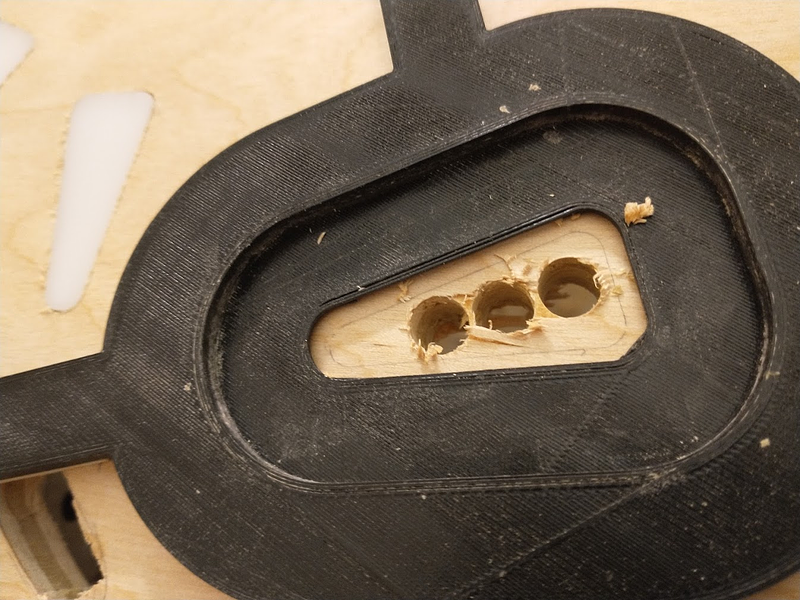
Midway through I stumbled upon this technique, drilling three holes through first, then routing out the rest using the guide, which allows me to do all the routing in one pass (before it was three passes since I kept needing to stop and remove all the dust, etc). Then once it was cut and the insert test-fitted, I'd take the guide away and hand route between the three holes to leave a good open area in the center for the light.
I was hoping that the circular inserts would match up with my forstner bits, but not all of them did. The smallest one (5/8?) are perfect, a nice snug fit, but the 3/4" are just loose enough that they'll fall out from gravity if there's any vibration. I'd like to get these all press-fit if possible so I don't have to worry about gluing them, so I'm going to try to make another router guide for the 3/4"
Cross posted from the original Pinside thread, this is one of many posts regarding my third homebrew pinball machine, creatively nicknamed 'P3'
Got the LED strip today. Was surprisingly easy to get working using adafruit's python library, worked the first time. Sadly I don't want to use the python library so I'll need to explore alternatives for integrating it with the rest of the code. I did some experiments with inserts. The circular ones lit up fine, but the larger ones like the arrows had a bit of coverage issues.
It's hard to get good pictures of leds lit up, but
Here's a clear triangle insert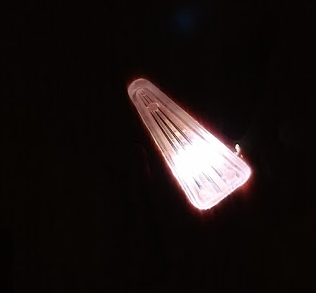
And here's an opaque one 
The clear one lit up a bit more evenly, but it didn't really look that good, you could clearly see the hot spot where the led was located. Surprisingly I think the opaque one looked better overall, and other colors seemed less washed out, which is nice since that's probably my only option...
I then played around with led placement. Putting it more towards the center or ends didn't help much; the ends were still pretty dim. What did help was cutting a bigger hole. here's a single led, positioned similarly to the previous photo, but with almost all of the insert cut through the playfield instead of just one hole the size of the led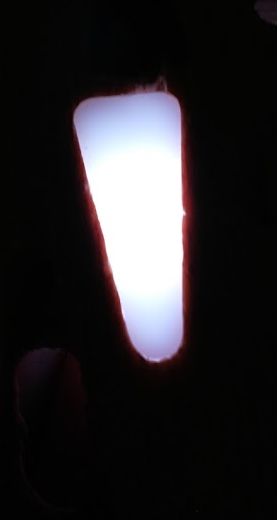
Probably good enough for me. I'll need to come up with a better way to cut those inner holes out, maybe another 3d printed router guide or something.
I also played with two leds under the same insert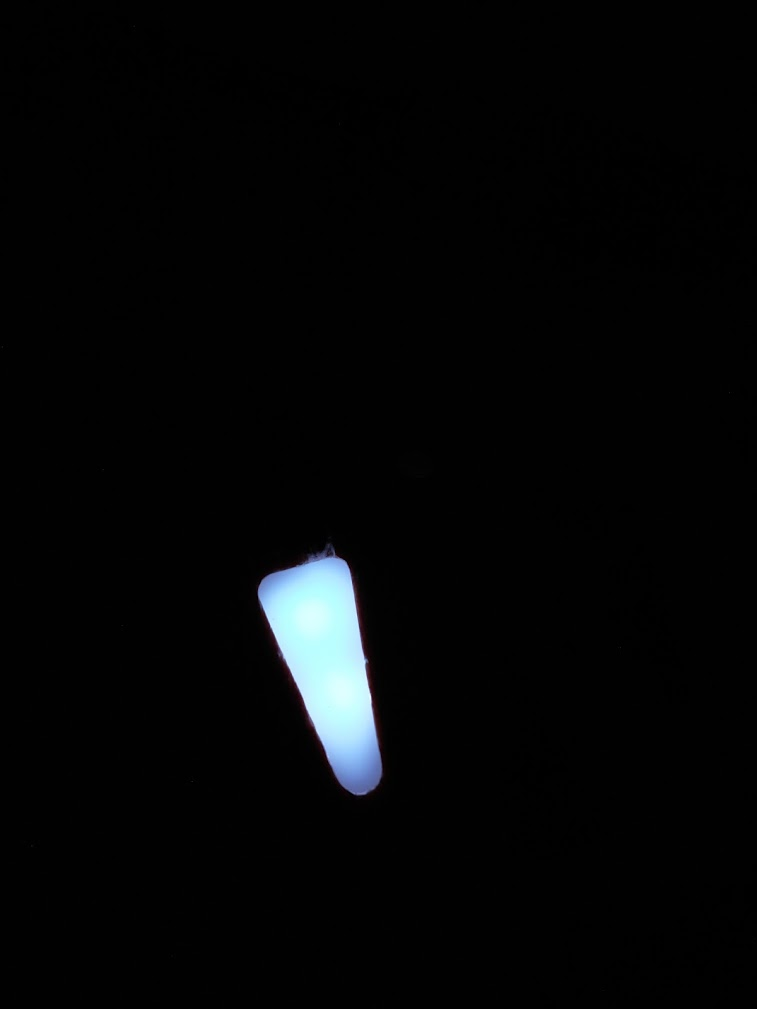
This looks a bit better than just one, but not as good as I was expecting. The hot spots seem more pronounced. I'm not sure if I'll be able to position the strip to hold two leds inside the arrow or not (the clamps haven't arrived yet). This is where a lot of people seem to use multi-led boards, which might be worth it at least for the main shots? I'll have to look around
Cross posted from the original Pinside thread, this is one of many posts regarding my third homebrew pinball machine, creatively nicknamed 'P3'
Since I had the playfield torn down, I figured I might as well install the inserts too. I've got a big bag of random inserts I've collected over the years from different stores, so I started laying them out. 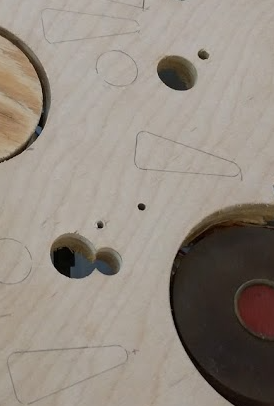 To keep things simple, I used one size of arrow (1.5" triangle) and three circles. I think the circles can probably be done with a forstner bit, but the arrow will need to be done with a router. Taking some advice from
To keep things simple, I used one size of arrow (1.5" triangle) and three circles. I think the circles can probably be done with a forstner bit, but the arrow will need to be done with a router. Taking some advice from ![]() Johnsonvillebrat, I designed a guide for my router
Johnsonvillebrat, I designed a guide for my router 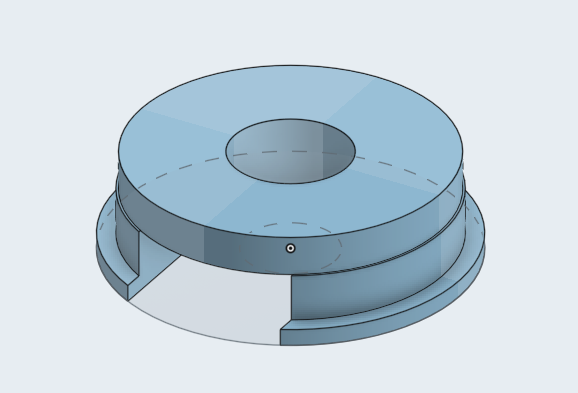
and a guide for the shape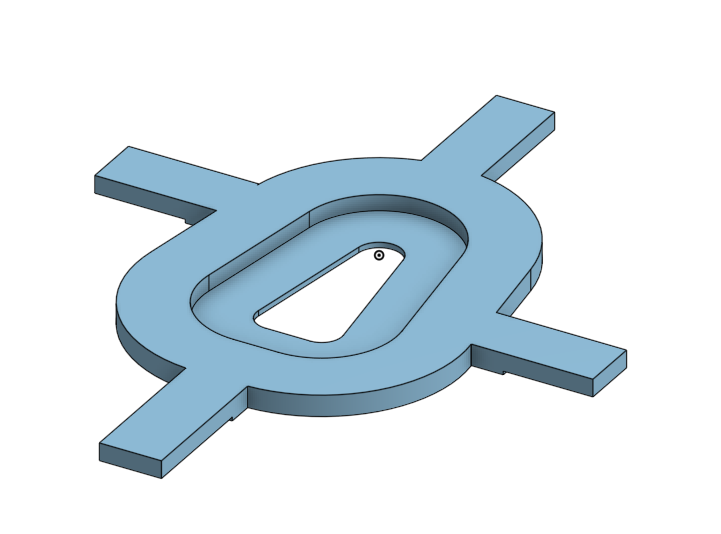
It took about 10 tries to get the guide just right for a snug fit (a big pain, since each print took 3 hours!) but I eventually got it just right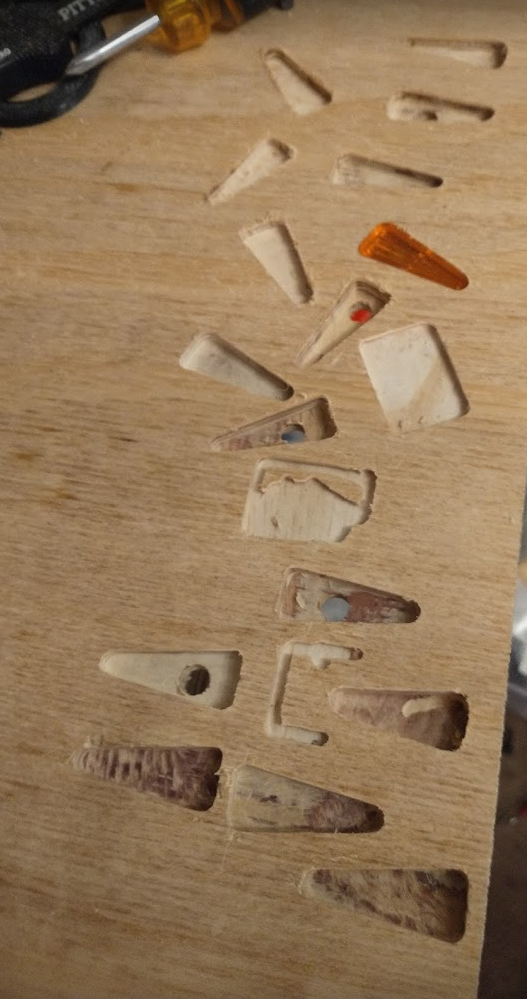
and made my first cut in the playfield
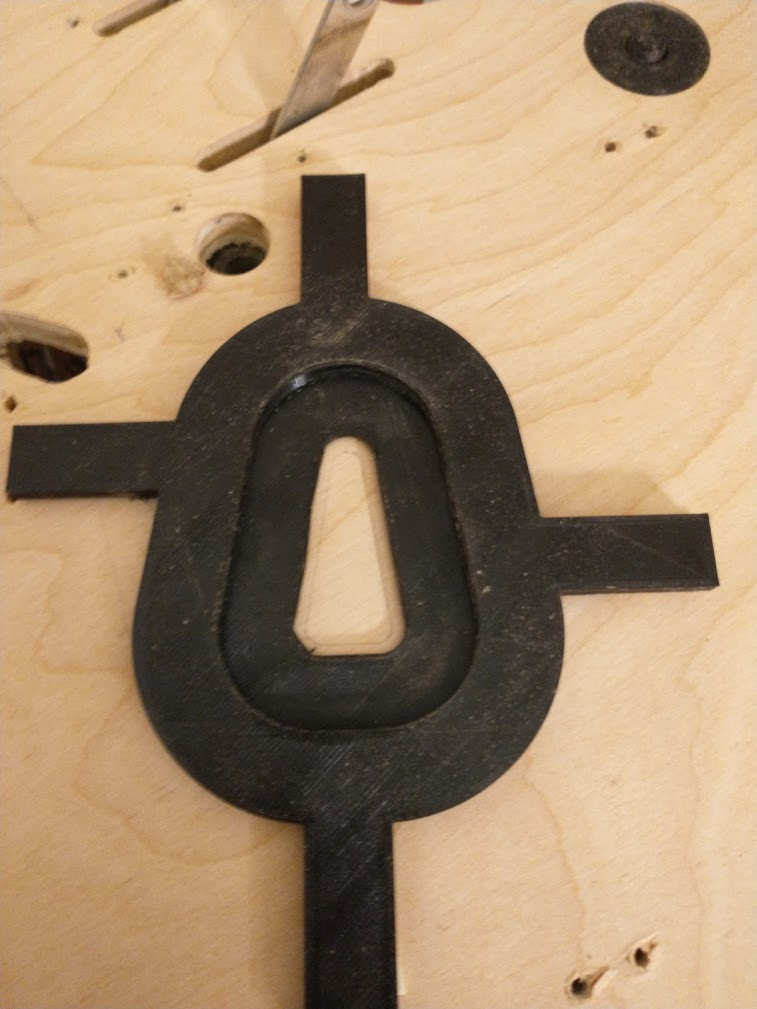

....aaaand immediately ran into an issue.
Can you spot the difference between these two arrows? 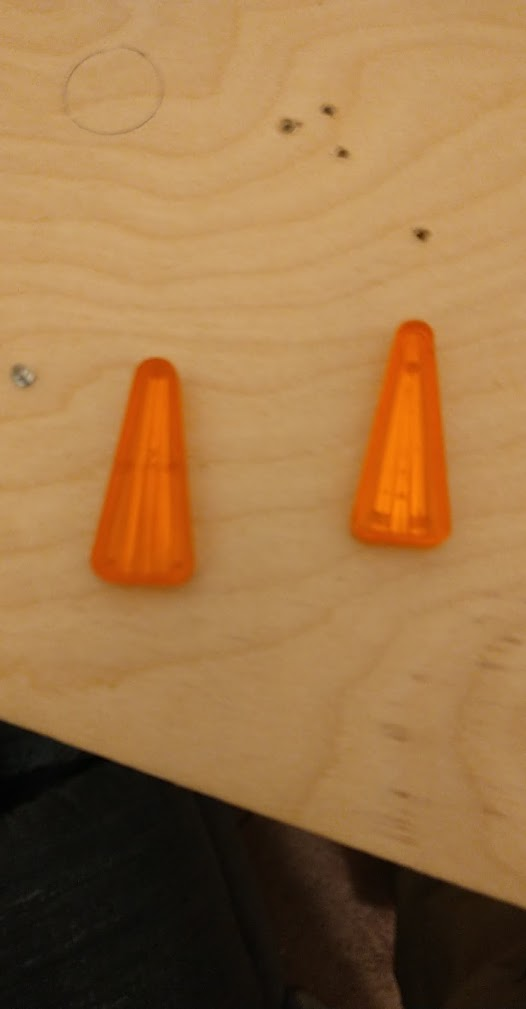
One is wider at the tip! I sorted through my inserts and found out that half of them won't fit the guide I made, which also means I don't have enough of the correct inserts for the playfield. I was planning on making them all clear, uncolored, for RGB lights, but I don't have enough of those. So I went to order more.
...aaaaand no one stocks them! (unless I want to pay $5 each shipped from europe) What? A transparent arrow should be like, one of the most common ones needed. Pinball Life (who has a great selection of inserts for homebrew) has six colors... but no clear. And they don't have any plans for restocking. The best I can find is that PBR has some opaque white inserts available, but I'm not sure how that'll look since every modern game I know of with RGB lighting uses transparent.
Luckily, I had one of those in my assortment, so I figured I'd stick it over an led and see how it compared.
...which made me realize I have no RGB leds. In fact, I have no real plan at all for how to light all these inserts! Back when I was first planning out this electronics system years ago when RGB was still a bit new, I figured I'd just get some 4-legged RGB LEDs , and then just stick them in a matrix. Except I don't have any boards designed to drive a matrix. And after wiring up the switch matrix, I really don't want to wire up another whole matrix with double the wires. It seems like today everyone is using NeoPixels and other individually addressable, chainable LEDs (well, besides stern, but), so I started looking into what'd be the cheapest, easiest, least messy way to get some of those installed. Luckily when I designed my MPU I added a spare connector for the 3 extra unused GPIO the RPi had, and I made sure that one of those was the DMA pin that's commonly used to drive these LEDs from a Pi, so I think I can drive them. If not I can get a FadeCandy or something. It seems like a lot of people are just buying FAST's individual LED boards, but they're $1.50 each, and need wiring to connect them all. So I ordered 5 meters of addressable LED strip (150 LEDs) off eBay for $15, and some mounting clips for $5. I'm hoping I can just string this through the playfield to reach all my lights, and use the spare LEDs in between as free wiring (just don't turn them on). Maybe that'll work, or not. I can always find a use for 5M of LEDs at worst though.
, and then just stick them in a matrix. Except I don't have any boards designed to drive a matrix. And after wiring up the switch matrix, I really don't want to wire up another whole matrix with double the wires. It seems like today everyone is using NeoPixels and other individually addressable, chainable LEDs (well, besides stern, but), so I started looking into what'd be the cheapest, easiest, least messy way to get some of those installed. Luckily when I designed my MPU I added a spare connector for the 3 extra unused GPIO the RPi had, and I made sure that one of those was the DMA pin that's commonly used to drive these LEDs from a Pi, so I think I can drive them. If not I can get a FadeCandy or something. It seems like a lot of people are just buying FAST's individual LED boards, but they're $1.50 each, and need wiring to connect them all. So I ordered 5 meters of addressable LED strip (150 LEDs) off eBay for $15, and some mounting clips for $5. I'm hoping I can just string this through the playfield to reach all my lights, and use the spare LEDs in between as free wiring (just don't turn them on). Maybe that'll work, or not. I can always find a use for 5M of LEDs at worst though.
In the mean time I've also ordered a bunch of opaque white inserts from PBR, since they're cheap and I needed some other parts anyway. Hopefully they light up well. Maybe the opaque inserts will give it a more retro feel? Of course, I don't know if the random opaque triangle insert I had lying around is from PBR or not, so cutting (and thus, reassembling) the playfield needs to go on hold for now until the order arrives so I know whether I need to design a new router guide ![]()
Cross posted from the original Pinside thread, this is one of many posts regarding my third homebrew pinball machine, creatively nicknamed 'P3'
Ran a test cut of one 4x5" area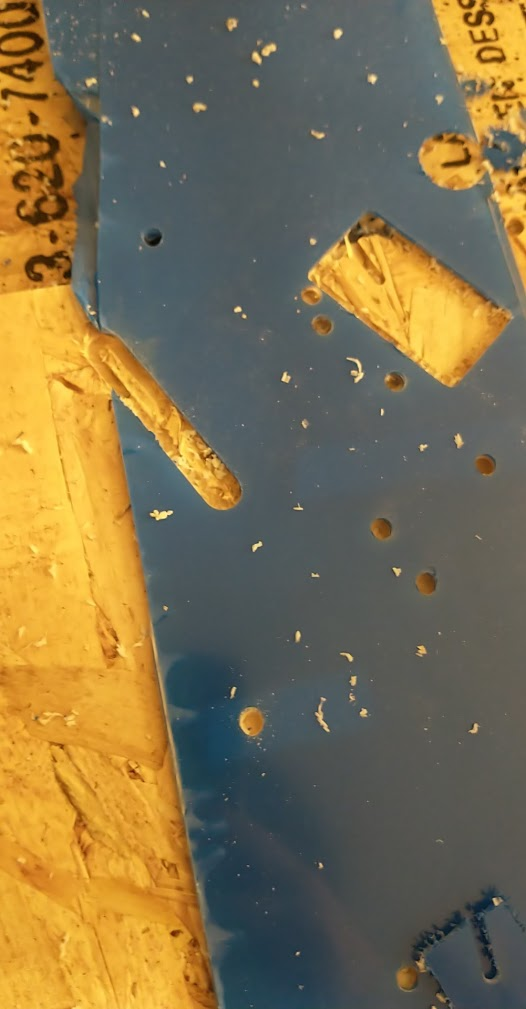
It turned out fine, no obvious issues. 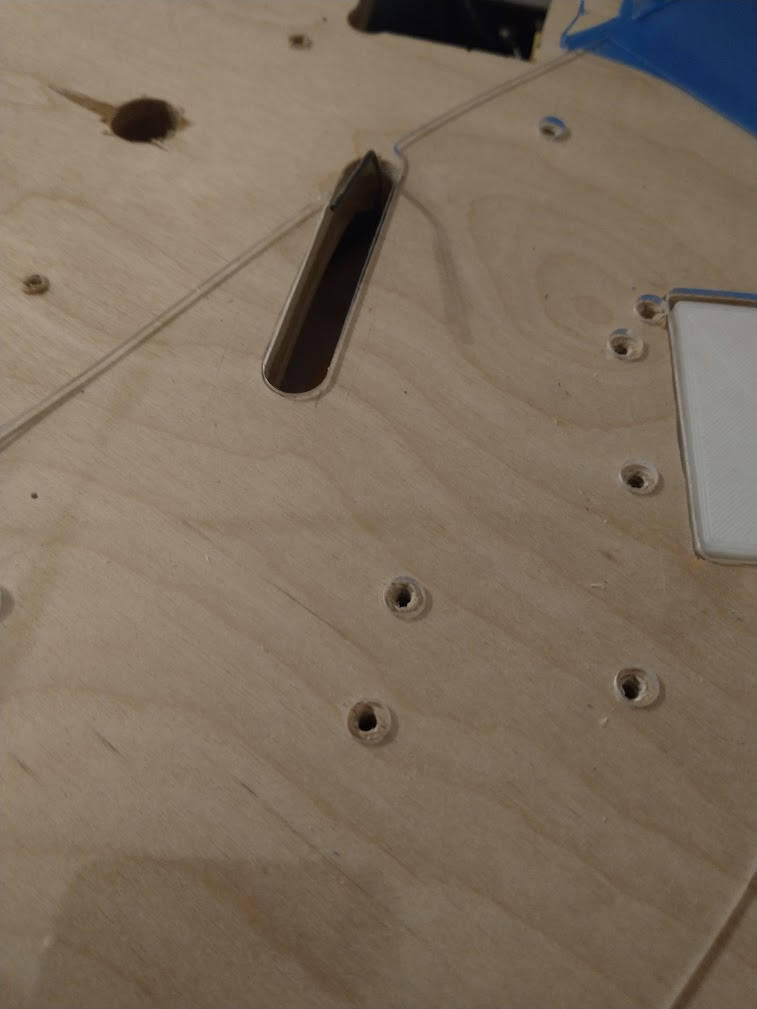
so I went and did the whole thing. I took one of my rough manual cuts, and stuck it down with a bunch of double sided tape. In retrospect I should have used thinner tape, as during the cut I could see the plastic flexing downward before the bit broke through, but it doesn't seem to have caused any issues with the cut.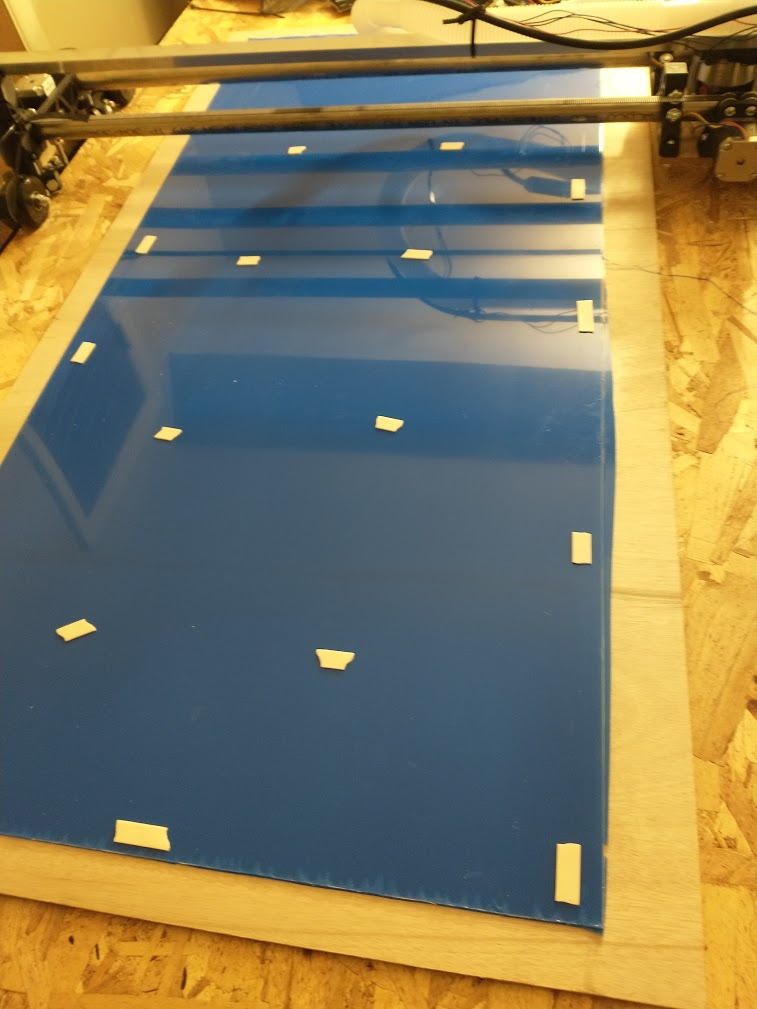
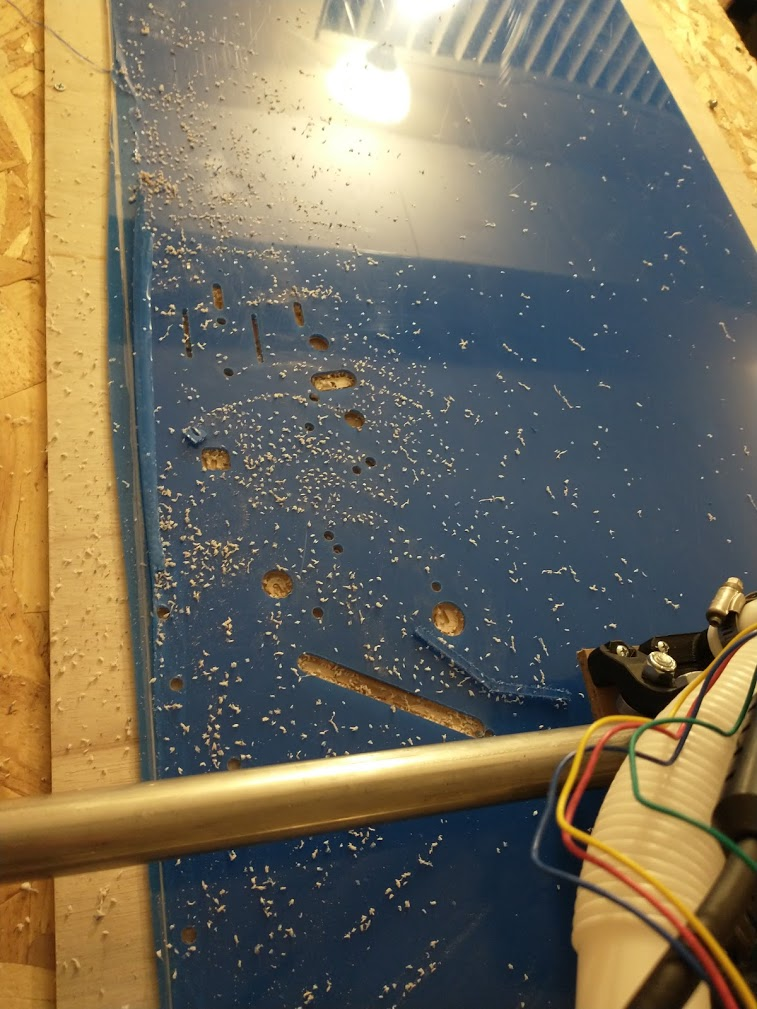
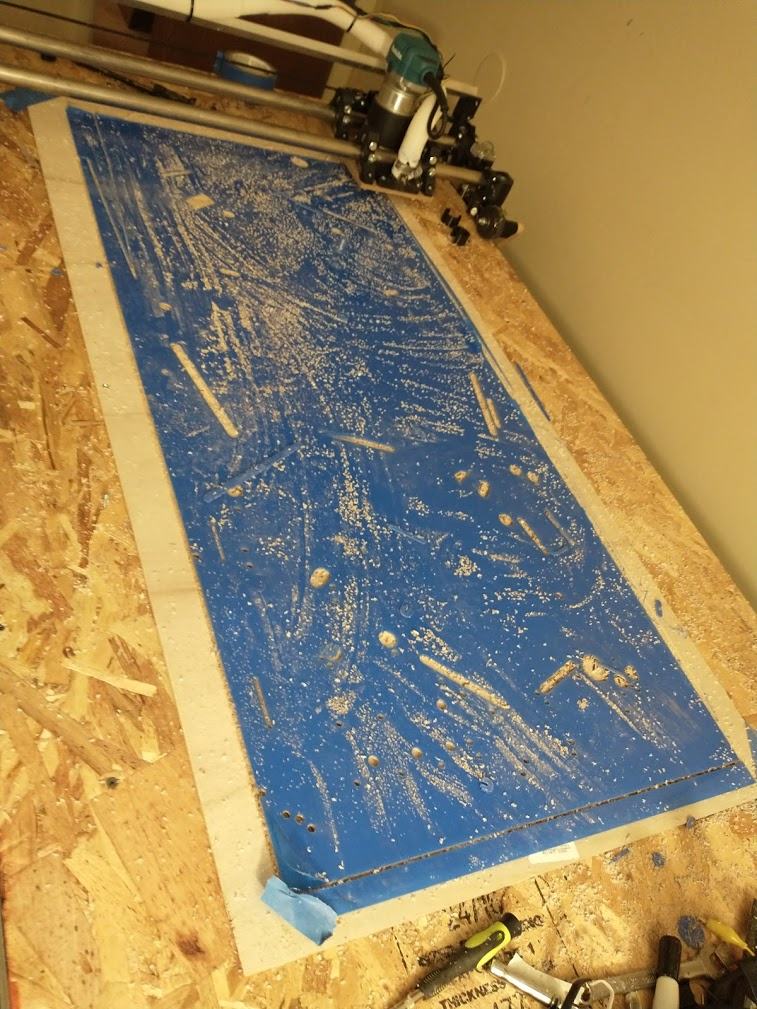

My first time running a real job on the CNC, probably took about 40 minutes. Plastic seems to have come out fine, and it at least fits on the playfield.
 Most of the holes are off center, but not outside the margin of error (I made every hole bigger than needed).
Most of the holes are off center, but not outside the margin of error (I made every hole bigger than needed). 
 There's a few places that need some correction, so I need to figure out how to do that. Aligning the plastic perfectly was a big pain, I don't think I could reliably get it matched up again. But I want to avoid doing stuff 'by hand' for risk of cracking the plastic. Maybe I'll need to use the router manually? Or try to run the CNC with manual control. Before I bother with any of that though, I should probably secure this down again and do some more heat tests.
There's a few places that need some correction, so I need to figure out how to do that. Aligning the plastic perfectly was a big pain, I don't think I could reliably get it matched up again. But I want to avoid doing stuff 'by hand' for risk of cracking the plastic. Maybe I'll need to use the router manually? Or try to run the CNC with manual control. Before I bother with any of that though, I should probably secure this down again and do some more heat tests.
I went in multiple times to try to do the corrections to the layout, but something just wasn't making sense. The corrections weren't all in the same direction, but different parts of the playfield tended to all need correcting in the same direction, and half the time that direction was opposite of how i'd already corrected those points before. In addition, the way I lined up the plastic so that it lined up with holes the closest resulted in it not being parallel with the edges, which didn't make sense either. When I lined it up with the edges of the playfield, right to the corners (where I know it should all match up), none of the holes lined up at all. So I stopped working on that until I could figure out what was going on. I measured various parts of the plastic and the wood playfield, and checked them against my CAD drawings, and they were all accurate. Then I got a t-square out to check if maybe my playfield somehow wasn't square. Nope, playfield was square. But the plastic wasn't! It had a 3/8" skew to it along its entire length. There must have been something wrong with the setup of the CNC causing it to list to the right as it moved up the playfield, so I'll need to figure that out. Never noticed in my test cuts since all of them were smaller. So that plastic is a loss for any real work. But knowing that it's wrong, I don't have to worry about fixing it the right way. So I just got out a router and adjusted all the holes by hand to line up enough. I'll reassemble the playfield on this bad plastic for now to test out the material.
Cross posted from the original Pinside thread, this is one of many posts regarding my third homebrew pinball machine, creatively nicknamed 'P3'
But before I can cut some new stuff, I need some drawings to cut! I took my scan of the original playfield, and converted it back into a cad drawing (what a pain!). Then I got that printed out on paper at 1![]() scale again, tore down the playfield, and laid the paper down on the playfield to verify everything, since I wasn't sure if the scans would be "square".
scale again, tore down the playfield, and laid the paper down on the playfield to verify everything, since I wasn't sure if the scans would be "square".
Sadly you can't see through paper (it would have been amazing to get this printed on something clear but as always I'm being cheap), so I had to use a small screw to search out all the holes in the playfield again for comparison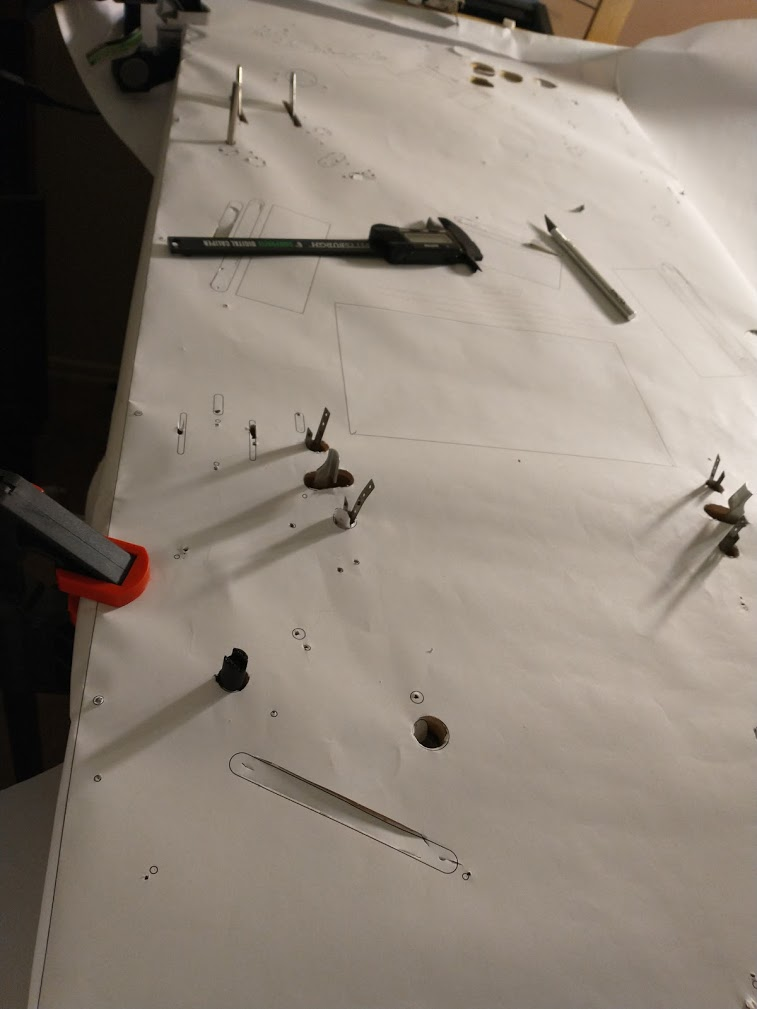
Some parts were spot on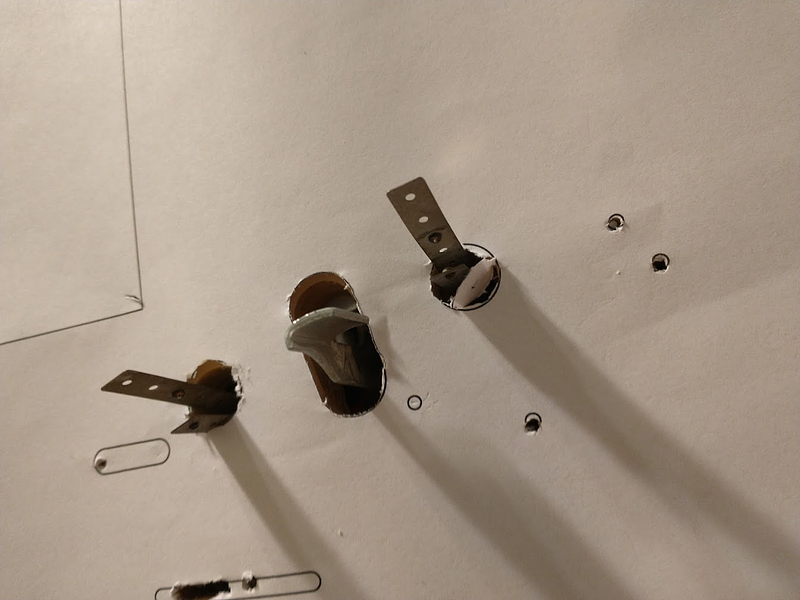
Some were off, but very consistently so
And some things were so far off I don't know what could have happened... 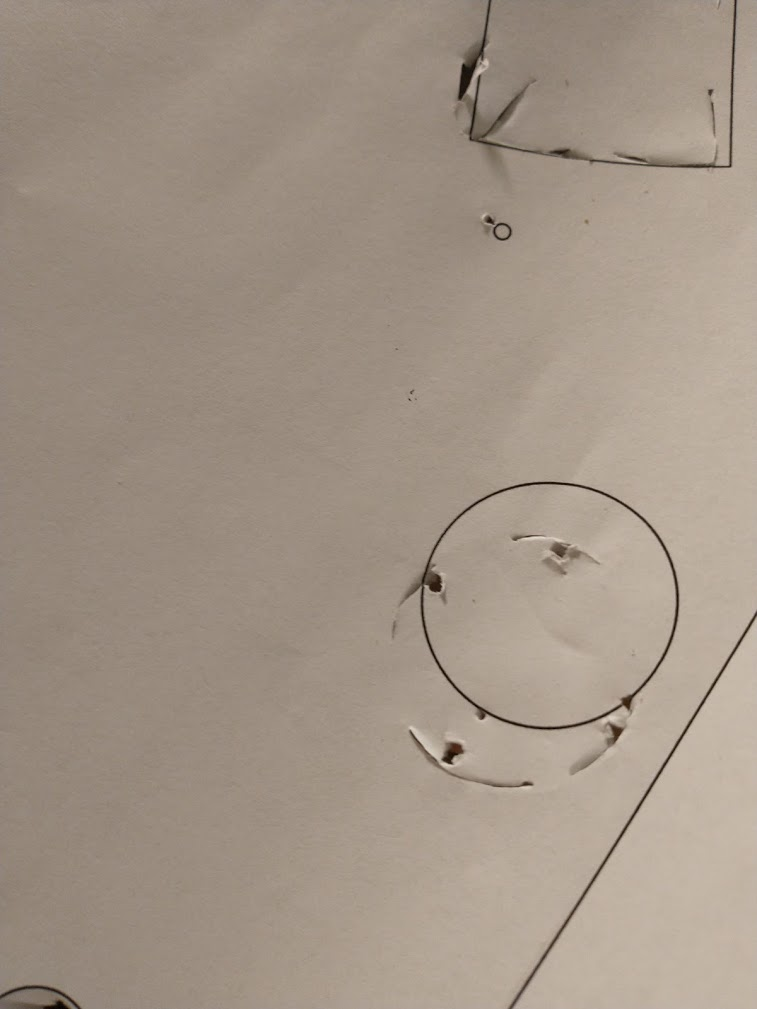
Overall, the stitching seems to have worked pretty well, but not good enough to really be a go-to thing. In the future I'll need to be more vigilant about cutting stuff exactly matching the cad, and adjusting the cad as I go when anything diverges to prevent this.
I spend most of my day off today going through every hole again and manually adjusting my cad drawing (which the paper was printed from) to account for the discrepancies, so hopefully I'm now good to go. I'd like to avoid having to get another throwaway paper printed to verify all my changes, and I've got 3 sheets of acrylic ready to go, so I'm tempted to do a few test cuts on leftover stuff, then just get cutting and see how I do. Probably not the smartest thing to do but at some point you've gotta stop preparing and just jump in, and the cost of failure is theoretically pretty low (or it would be if I could find any reliable source of plastic locally, grr)
Cross posted from the original Pinside thread, this is one of many posts regarding my third homebrew pinball machine, creatively nicknamed 'P3'
Two months of no real progress on the game, but: I've got a CNC router! 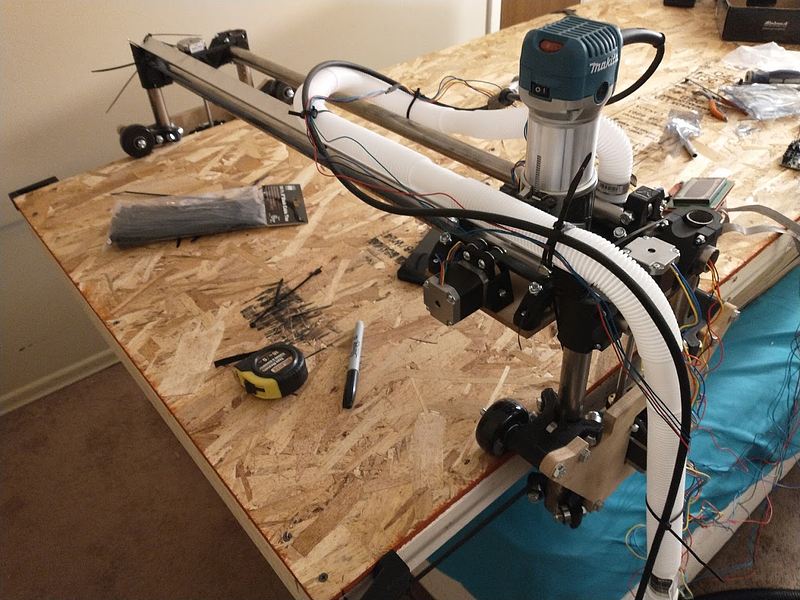
It's... currently sitting on top of the bed in my spare bedroom, because I horribly underestimated how big it would be. But that's fine, not many guests during COVID. I haven't done any really big serious work with it yet, but it seems to work fine for my small tests I've run so far, so I don't think anything should change much.
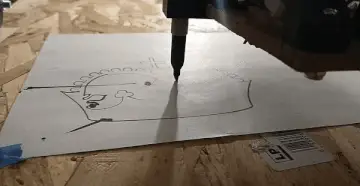

I did some test cuts using a straight edged router bit (not sure the correct term for this), which was recommended for cutting plastics (since it doesn't have a helix to pull up the material). With a spare bit of lexan, it didn't do too well, sorta ripping up the edges and melting them a bit, similar to the issues I had cutting my lexan by hand with a drill. I got a sheet of 1/16" acrylic and tried that, and it cut much better. Not perfect, but definitely presentable. The only issue is that acrylic has a tendency to crack and shatter randomly. The router bit hasn't caused any of that yet, but when doing a whole playfield it could potentially cause an issue. I also tried another scrap of plastic I had on hand (which I think is PET-G, but I didn't label it), and it cut super nice. I'm trying to source some PET-G sheets locally to test out but I haven't found anything so far, so I'm gonna go ahead and try the thicker acrylic first. Acrylic also is (supposedly) what 70s+80s games with plastic playfields used, and what other homebrews have, so I'm still hopeful it'll work.
Cross posted from the original Pinside thread, this is one of many posts regarding my third homebrew pinball machine, creatively nicknamed 'P3'
After a few multi-hour sessions with the glass on, the plastic has finally started buckling. Worse, after I left it to cool off for a day, it's still not lying completely flat again. I assume if I stripped and repopulated the whole playfield I could fix it, temporarily, but not a permanent solution...
I've been told that this method worked successfully on some homebrew pins, but using 1/16" perspex (acrylic). When I went to my local plastics shop to buy some, they recommended I use lexan instead for this application, as it shouldn't react to heat any more than acrylic and would hold up to the pinball better, but months later when I finally unboxed the sheet and measured it, it seems to be 1/32" per my calipers. So maybe a thicker sheet would work, or maybe the material is wrong. Or maybe I'm missing something else... I don't really want to hand cut another one of these after all the effort the first one took either. Maybe I'll shell out to get one laser cut, if I can get a good cad file together...
I've also ordered a CNC router (https://www.v1engineering.com/lowrider-cnc/) that hopefully I can eventually use to cut new playfields and maybe plastic sheets (or even longer term goals, I get my own laser cutting head to attach to it), so maybe I'll wait on addressing this issue for a while. Moving back to a clearcoated playfield is always an option, it'll just add a ton more complications and steps to deal with...
